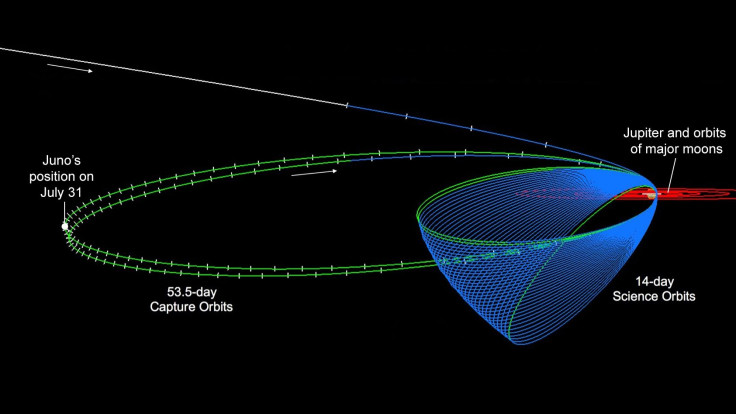NASA’s Juno Spacecraft Heads Back Toward Jupiter After Completing Half Of Its First ‘Capture Orbit’

NASA’s Juno has turned a corner and is now falling back toward Jupiter. The spacecraft, which successfully entered into orbit around the gas giant on July 4, reached the farthest point of 5 million miles in its orbit — “apojove” — at 3:41 p.m. EDT.
Now, the spacecraft is zooming back toward Jupiter with its “scientific eyes wide open,” and will, on Aug. 27, finish its first lap of Jupiter. On that day, it will fly by Jupiter at a distance of just 2,600 miles above its dense cloud tops.
I’ve started falling back toward #Jupiter, this time with my science eyes wide open https://t.co/essskpLceu pic.twitter.com/Mf4YmY608A
— NASA's Juno Mission (@NASAJuno) July 31, 2016
“We're in an excellent state of health, with the solar-powered spacecraft and all the instruments fully checked out and ready for our first up-close look at Jupiter,” Rick Nybakken, Juno project manager at NASA's Jet Propulsion Laboratory, Pasadena, California, said in a statement released Friday.
This maneuver allows Juno, which was launched in August 2011, to be captured by Jupiter’s gravity, and is thus known as a “capture orbit.” If all goes well, once the spacecraft completes both of its 53.5-day-long capture orbits, it will begin its science mission by shortening the orbital period to 14 days.

“Juno's science instruments were turned off during orbit insertion, to simplify spacecraft operations during that critical maneuver,” NASA said in the statement. “In contrast, all the instruments will be collecting data during the Aug. 27 pass, which serves as a trial run before the mission gets to work collecting the precious data it came for.”
Juno's camera — “JunoCam” — was also shut down during orbit insertion, but has since been turned on. In order to help NASA decide what photos it takes during its closest approaches, amateur astronomers, students and those interested in the mission can, come fall, go to this website and begin voting on the points of interest in the gas giant.
The primary goals of the $1.1 billion mission are to find out whether Jupiter has a solid core, and whether there is water in the planet's atmosphere — something that may not only provide vital clues to how the planet formed and evolved, but also to how the solar system we live in came into existence.
In order to accomplish these goals, Juno will orbit over Jupiter’s poles and pass very close to the planet. It will orbit Jupiter 37 times in the almost one-and-a-half-year science phase of the mission.
“For five years we've been focused on getting to Jupiter. Now we're there, and we're concentrating on beginning dozens of flybys of Jupiter to get the science we're after,” Scott Bolton, Juno principal investigator at Southwest Research Institute in San Antonio, said in the statement.
© Copyright IBTimes 2024. All rights reserved.






















